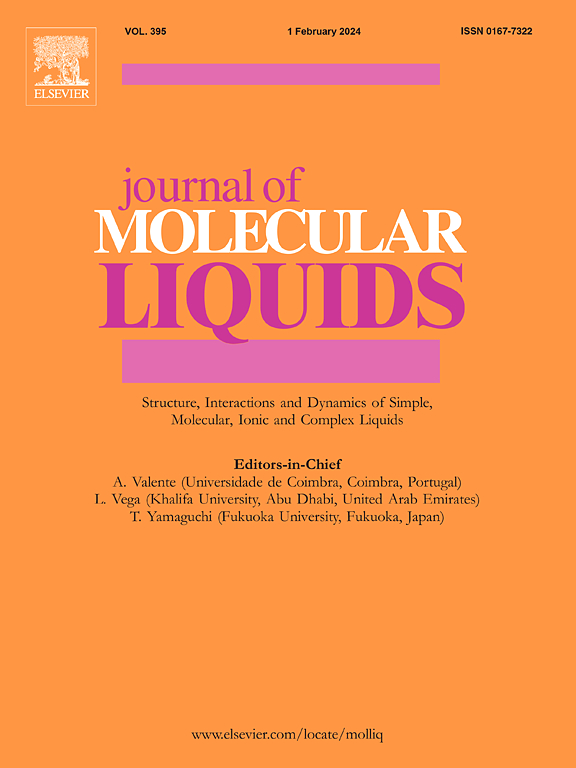Molecular dynamic insight into imidazolium based deep eutectic solvent comprising carboxylic acids (C2 and C3): Experiments and DFT approach
IF 5.3
2区 化学
Q2 CHEMISTRY, PHYSICAL
引用次数: 0
Abstract
The physical properties including speed of sound (u), densities (ρ), refractive indices (nD) for the binary systems of 1:3 mol ratio of [1-butyl-2,3-dimethylimidazolium chloride to ethylene glycol], [BDMIM]Cl: EG], deep eutectic solvent (DES) and selected carboxylic acids (acetic acid and or propanoic acid) were measured including those of pure DESs at temperatures ranging from (293.15–313.15) K at atmospheric pressure using Anton Paar densitometer and Anton Paar refractometer. The measured data was used to calculate excess molar volumes (), deviation in isentropic compressibilities (Δ), intermolecular free length (Lf), deviation in refractive indices (ΔnD) and isentropic compressibilities (ks), these thermodynamic properties will be used to examine the types of intermolecular interactions between the prepared systems comprising imidazolium DES and acetic acid or propanoic acid. DFT calculations, natural bond order (NBO) analysis, electron localization function (ELF) and non-covalent interaction (NCI) analysis was done to understand the interactions occurring with DES and DES-carboxylic acid systems. Molecular Dynamics Simulations were also done for 250 ns to study root mean square deviation, root mean square fluctuations and radial distribution function of DES and DES-carboxylic acid systems. Lorentz-Lorenz equation was applied to correlate the volumetric properties and to predict the density and the refractive indices of binary mixtures. The predicted data were in good agreement with the experimental data.
求助全文
约1分钟内获得全文
求助全文
来源期刊

Journal of Molecular Liquids
化学-物理:原子、分子和化学物理
CiteScore
10.30
自引率
16.70%
发文量
2597
审稿时长
78 days
期刊介绍:
The journal includes papers in the following areas:
– Simple organic liquids and mixtures
– Ionic liquids
– Surfactant solutions (including micelles and vesicles) and liquid interfaces
– Colloidal solutions and nanoparticles
– Thermotropic and lyotropic liquid crystals
– Ferrofluids
– Water, aqueous solutions and other hydrogen-bonded liquids
– Lubricants, polymer solutions and melts
– Molten metals and salts
– Phase transitions and critical phenomena in liquids and confined fluids
– Self assembly in complex liquids.– Biomolecules in solution
The emphasis is on the molecular (or microscopic) understanding of particular liquids or liquid systems, especially concerning structure, dynamics and intermolecular forces. The experimental techniques used may include:
– Conventional spectroscopy (mid-IR and far-IR, Raman, NMR, etc.)
– Non-linear optics and time resolved spectroscopy (psec, fsec, asec, ISRS, etc.)
– Light scattering (Rayleigh, Brillouin, PCS, etc.)
– Dielectric relaxation
– X-ray and neutron scattering and diffraction.
Experimental studies, computer simulations (MD or MC) and analytical theory will be considered for publication; papers just reporting experimental results that do not contribute to the understanding of the fundamentals of molecular and ionic liquids will not be accepted. Only papers of a non-routine nature and advancing the field will be considered for publication.
 求助内容:
求助内容: 应助结果提醒方式:
应助结果提醒方式:


